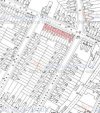Opposite, on the corner of Balfour St,, behind the children who seem to have been following me around and playing in a manner probably not seen today or for many years, is 93 Mary St. Up till around 1893,when the street was renumbered it would have been no 37. It has obviously been empty for awhile. The last occupiers were listed in 1969. Alloy Finishes, an electroplating company, had been there since shortly after WW2, but disappeared from Birmingham after leaving this site. For a short time in the 1930s it had been a furniture dealers run by William Frederick Kibby, who also had another furniture shop in Moseley Road, and who had previously for many years been a pawnbroker in Bellbarn Road. Before WW1 George Humphreys had also used it for furniture dealing for a short time, but for over forty years, almost from when the building was built there had been a series of greengrocers on the site, the longest serving tenant of these being George Twitty. His main base was in Smithfield Market, but he ran the shop here for about 17 years up till about 1904, and the firm of George Twitty Ltd survived until the late 1960s, despite their warehouse in Skinner Street being burned down in October 1939.
The buildings to the right of no. 93 in more recent years were purely residential. No 91 had been the home of the Coleman family since the early 1920s, but from the mid 1880s till 1895 was home and workshop to William Edward Woodward who then moved to Lionel Street. He began as a glass embosser, but progressed to glass gilder, producing the elaborate advertising signs and mirrors that are so characteristic of Victorian scenes. His son Wilfred was assistant to him, as was Alfred Zeppaniah, son of the bootmaker Randall Zeppaniah from Gloucestershire at no 89. No. 87, the house on the far right, had many uses, being a fresh fish shop in 1883, quickly changing to a more profitable fried fish shop within a year, which it remained for about six years. The then fish fryer, William Hartshorne, with his wife Lavinia became a general shopkeeper for a further ten years before leaving. Just before WW1 the shop returned to frying fish for a while under George Legge, but by 1921 was a fancy drapers. Taken over by Annie Eacock in 1926, she continued running it as a drapers till the early stages of WW2, but after the war her daughter, Edna, set up a dressmaking business there which continued till the early 1950s, still retaining the Eacock name after her marriage in 1948 to Stanley Mokes. She remained living there till the early 1960s.

The buildings to the right of no. 93 in more recent years were purely residential. No 91 had been the home of the Coleman family since the early 1920s, but from the mid 1880s till 1895 was home and workshop to William Edward Woodward who then moved to Lionel Street. He began as a glass embosser, but progressed to glass gilder, producing the elaborate advertising signs and mirrors that are so characteristic of Victorian scenes. His son Wilfred was assistant to him, as was Alfred Zeppaniah, son of the bootmaker Randall Zeppaniah from Gloucestershire at no 89. No. 87, the house on the far right, had many uses, being a fresh fish shop in 1883, quickly changing to a more profitable fried fish shop within a year, which it remained for about six years. The then fish fryer, William Hartshorne, with his wife Lavinia became a general shopkeeper for a further ten years before leaving. Just before WW1 the shop returned to frying fish for a while under George Legge, but by 1921 was a fancy drapers. Taken over by Annie Eacock in 1926, she continued running it as a drapers till the early stages of WW2, but after the war her daughter, Edna, set up a dressmaking business there which continued till the early 1950s, still retaining the Eacock name after her marriage in 1948 to Stanley Mokes. She remained living there till the early 1960s.



































